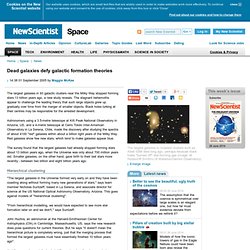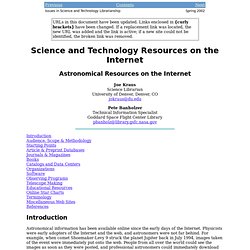

Multiverse & Universe Origins. Extrasolar systems & exoplanets. Outer space. Extraterrestrial life. Velikovsky and others. Stars & Space Photography. Cameronr. Space tech. Space : Discovery Channel. Maverick science.com. Embrace the lumpiverse: How mess kills dark energy - physics-math - 25 June 2014. (Image: Darren Hopes)

Dead galaxies defy galactic formation theories - space - 01 September 2005. The largest galaxies in 93 galactic clusters near the Milky Way stopped forming stars 13 billion years ago, a new study reveals.

The stagnant behemoths appear to challenge the leading theory that such large objects grew up gradually over time from the merger of smaller objects. Black holes lurking at their centres may be responsible for the arrested development. Astronomers using a 3.5-metre telescope at Kitt Peak National Observatory in Arizona, US, and a 4-metre telescope at Cerro Tololo Inter-American Observatory in La Serena, Chile, made the discovery after studying the spectra of about 4100 "red" galaxies within about a billion light years of the Milky Way.
Red galaxies show few new stars, which tend to make galaxies appear blue. The survey found that the largest galaxies had already stopped forming stars about 13 billion years ago, when the Universe was only about 700 million years old. Astronomical Resources on the Internet. Astronomical Resources on the Internet Joe Kraus Science Librarian University of Denver, Denver, COjokraus@du.edu Pete Banholzer Technical Information Specialist Goddard Space Flight Center Librarypbanholz@library.gsfc.nasa.gov IntroductionAudience, Scope & MethodologyStarting PointsArticle & Preprint Databases Journals & Magazines Books Catalogs and Data Centers Organizations Software Observing Programs Telescope Making Educational Resources Online Star Charts Terminology Miscellaneous Web SitesReferences Introduction Astronomical information has been available online since the early days of the Internet.

Many astronomical organizations have been ahead of the curve in utilizing the Internet for electronic publication. Worldwide, amateur astronomers greatly outnumber professional astronomers. It's crunch time for dark matter if WIMPs don't show - space - 28 May 2014. If dark matter isn't made of WIMPs, could neutrinos or axions fit the bill?

What if it's not a particle at all but a strange modification of gravity? ROADS may soon diverge in the dark matter wood, and some physicists want to take the ones less travelled. The most promising candidate for a dark matter particle could be about to show itself at last, as it is running out of places to hide. Space's 10 Most Gigantic Objects. Newborn Star's 'Snow Line' Reveals Clues About Planet Formation. Astronomers have identified the point where carbon monoxide (CO) freezes in the disk around a sunlike star — information that could help them understand how planets form.

A team of international scientists has calculated the CO "snow line" for a star called TW Hydrae, determining that the gas solidifies at about the distance of the orbit of Neptune, where it could help feed the formation of the outer edges of the system. "The CO snow line is interesting, not only because CO is abundant in the disks, but its snow line is the most accessible to direct observations due to its low freeze-out temperature — it's farther away from the star," said principal investigator Chunhua Qi of the Harvard-Smithsonian Center for Astrophysics.
"It could mark the starting point where smaller icy bodies, like comets, and dwarf planets, like Pluto, would begin to form. " Lost Opportunity. NASA Funds 12 Far-Out Space Tech Ideas. NASA has granted funding to a dozen imaginative tech concepts, in the hopes that one or more of them will lead to big breakthroughs in space science and exploration.

The 12 ideas, which were selected under Phase 1 of the NASA Innovative Advanced Concepts (NIAC) program, are ambitious and varied. One aims to build biomaterials such as human tissue with a 3D printer, for example, while another proposes to induce deep-sleep torpor states in astronauts making the long journey to Mars. "These new Phase 1 selections include potential breakthroughs for Earth and space science, diverse operations and the potential for new paths that expand human civilization and commerce into space," NIAC program executive Jay Falker said in a statement.
Astronomy Pronunciation Guide. Universe Sandbox. Edge of the Universe. Planetarium - Interactive star map and virtual sky. The Scale of the Universe 2. Actual Sound of Space - NASA Voyager Recordings. Interactive 3D model of Solar System Planets and Night Sky.
12 Pictures of Space You Won't Believe Aren't Photoshopped. Look, we all know that space is the final frontier, that space is cold and unforgiving and that in it, nobody can hear you scream.

But what you might not know is that, when it thinks nobody is looking, space puts on a frilly dress, covers its forearms in honey and spins around until it falls over ... because space is just flat-out crazy as hell. Oh, don't take our word for it or anything; we have photographic evidence. #12. Jupiter in Motion You know what Jupiter looks like -- kind of like a dirty marble -- and you know, objectively, that those bands and swirls you're looking at are all big storms. GIF BinIT'S GETTING CLOSER!
You might have seen this before in the movie Another Earth, but if not, well, now you have this time-lapse gif to haunt your existential nightmares for the rest of time. . #11. Big Bear Solar Observatory via Discovery News #10. Remember that famous face on Mars that turned out to be a big, fat nothing? The 6 Most Mind-Blowing Things Ever Discovered in Space. It's actually really easy to think of space as boring.

The planets in our own solar system all seem to be empty rocks or balls of gas, and you find a whole lot of nothing before you get to the next star. Meanwhile, Hollywood's most creative minds can't get past populating the place with planets that look a whole lot like Earth (and specifically, parts of California) featuring monsters, rapey aliens or Muppets. But real space is far, far stranger. You just have to know where to look to find things like ... #6. Scientists Now Know: We're From Sagittarius Dwarf Galaxy!
How the Universe Works S01E08 Part1. Super Moon at the Temple of Poseidon.